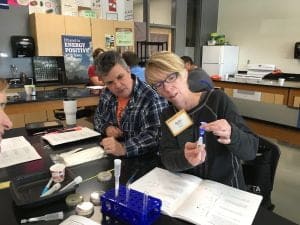
Through the Ag Sack Lunch program, UNL ag ambassadors explain how agriculture is responsible for their sack lunches they receive during the events.
Along with market development, research and promotion, education is one of the four key pillars of the Nebraska Corn Board. Through various programs, K-12 students from across the state are learning more about agriculture, which will hopefully impact their knowledge and understanding of the industry as they become future consumers and begin to determine future career paths.
“The Nebraska Corn Board has long partnered with youth organizations like 4-H and FFA and will continue to do so,” said Kelly Brunkhorst, executive director of the Nebraska Corn Board. “We know these youth are likely the next generation of ag leaders, and we understand the importance of providing them with the necessary tools and opportunities to help them succeed. We also understand we must reach our non-ag students across the state to help give them a solid foundation of agricultural production. Agriculture impacts everyone, yet many students are removed from the farm. By educating our youth, we’re not only helping them with their STEM (science, technology, engineering and math) development, we’re helping bridge the gap between consumers and farmers, ultimately increasing agricultural literacy.”
Programming starts at a young age, which is why the Nebraska Corn Board supports several educational efforts for younger students. Elementary school teachers have access to curriculum from the Ag in the Classroom program, which is organized by the Nebraska Farm Bureau Foundation. Ag in the Classroom reaches 24,000 students, 600 teachers and 3,500 volunteers each year. The Ag Sack Lunch program is designed for fourth grade students who are learning about Nebraska in their classrooms. As many of these classrooms are visiting the Nebraska Capitol, they are invited to take part in a free lunch program led by UNL students who are passionate about teaching these youth about agriculture. Roughly 5,000 fourth graders participated in this program during the 2018-2019 school year. Another opportunity for elementary students would be Nebraska Extension’s Ag Literacy Festivals, which reached over 6,700 students in 2018.

Science teachers from across the state took part in workshops in early-June to better understand how they can incorporate agriculture into their classrooms. For more information, visit nebraskacorneducation.org.
While many great middle and high school ag programs exist throughout the state, not all students are enrolled in these classes. However, all students have science requirements. Therefore, in 2018, Nebraska Corn invested in curriculum development for middle and high school science classrooms. This curriculum is focused on key issues, such as biotechnology, biofuels, water quality and soil and sustainability. To ensure teachers use the curriculum, the materials were designed to meet state science standards. Additionally, several professional development sessions were held to help teachers realize how they could incorporate agriculture into their classrooms with the curriculum.
There are many other ways the Nebraska corn checkoff is supporting youth across the state. If you’re an educator or know an educator who would benefit from any of these resources, email the Nebraska Corn Board at NCB.info@nebraska.gov.
Related Articles
Join the Nebraska Corn Board and Nebraska Corn Growers Association at Husker Harvest Days 2025
The Nebraska Corn Board (NCB) and the Nebraska Corn Growers Association (NeCGA) are set to welcome visitors to Grand Island, Nebraska for Husker Harvest Days, the world's largest totally irrigated working farm show, September [...]

